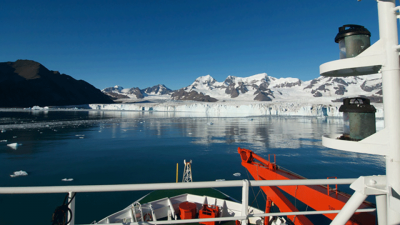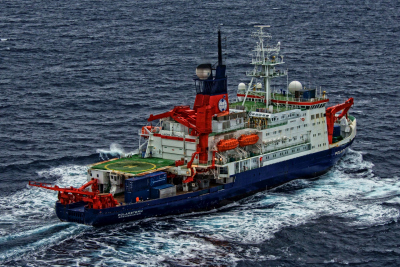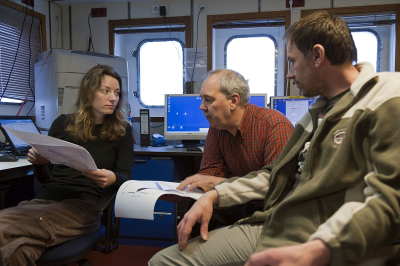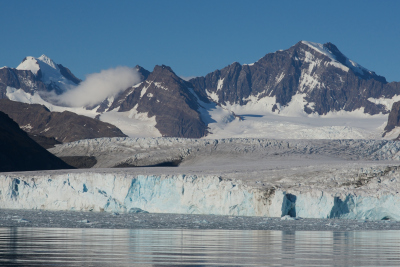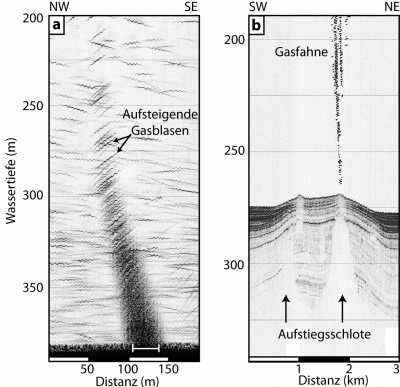Page path:
- Home
- Discover
- Media Releases
- Media Releases 2014
- Greenhouse Gases in the Southern Ocean
Greenhouse Gases in the Southern Ocean
Continental and marine seepage of methane is a research issue of global importance. According to the Intergovernmental Panel on Climate Change methane is about 21 times more powerful in warming the atmosphere than carbon dioxide. However, it is uncertain how much methane is emitted at the seafloor and whether it could eventually reach the atmosphere. To answer these and other questions, German, British, and US-American scientists embarked with the German RV Polarstern in the spring of 2013 in search of the Antarctic pieces of the global methane puzzle.
“Our hydro-acoustic survey with the shipboard echo sounders focused on two bays off the north-eastern coast of South Georgia”, says chief scientist Gerhard Bohrmann. “An especially close-meshed survey grid was carried out in Cumberland Bay, within visual range of the buildings of the historic whaling station at Grytviken.”
The survey produced remarkable results: “On the echograms the methane bubbles emanating from the seafloor appear as thin flares, some of which rise up to 25 meters below the sea surface”, says MARUM researcher Miriam Römer, first author of the recently published paper. “In water depths between 130 and 390 meters we identified a total of 133 methane flares, more than half of them located in the Cumberland Bay.” On the average these flares were 70 meters high. However, the highest vertically rising flare reached a height of 220 meters.
“We scanned the uppermost layers of the seafloor with a special echo-sounder”, adds Gerhard Kuhn, deputy chief-scientist and researcher at the Alfred Wegener Institute, Helmholtz Centre for Polar and Marine Research in Bremerhaven. “On our echograms we found evidence of sub-seafloor chimneys tens of meters below the surface that act as conduits to channel methane bubbles into the water column.”
The methane seeps off South Georgia differ from those near the Arctic island of Svalbard, which were the subject of earlier expeditions by MARUM and other international research teams. “In the Cumberland Bay, the gas-bubble plumes do not reach the upper water layers or the atmosphere, and thus our first assessment suggests that these plumes may not contribute to the greenhouse effect”, says expedition member Marta Torres, professor of oceanography at the College of Earth Ocean and Atmospheric Science at Oregon State University. “Another difference to note is that the methane plumes off Svalbard are thought to result from dissociation of methane hydrates, which is not the case off South Georgia. The methane seeps we discovered lie under less than 400 meters of water, whereas deeper waters, such as the ones off Svalbard, are needed to stabilize the methane hydrate structure.”
The rugged north-eastern coast of South Georgia, characterized by deep bays and inlets, offers optimal conditions for the development of methane plumes. Mountains up to 3,000 meters high shape the island throughout its length of 160 kilometers. Impressive glaciers, which in the past extended much farther out into the sea, have cut deep troughs into the seabed where present-day sediments from the land are accumulating. Simultaneously, the eastward-flowing Antarctic Circumpolar Current promotes the upwelling of nutrients from greater depths into the light-flooded upper water layers. The resulting high biological productivity generates organic-rich sediments. “These high sedimentation rates plus the input of sufficient amounts of organic matter are prerequisites for microbial methane formation”, says expedition member Sabine Kasten, head of the Marine Geochemistry Section at the Alfred Wegener Institute.
The new findings off South Georgia add to a long and steadily growing list of known methane seep areas in the world`s oceans. The research team is already planning another expedition into Antarctic waters, as many research questions remain unresolved: “Methane seeps out irregularly and episodically, a process which might be influenced by tides, storms, earthquakes, and other parameters”, says Miriam Römer. “We still have quite a long way to go before we will be able to present a methane balance quantifying regional seepage.”
Article:
M. Römer et al.: First evidence of widespread active methane seepage in the Southern Ocean, off the sub-Antarctic island of South Georgia; in Earth and Planetary Science Letters 403 (2014), S. 166 – 177.
More information / interviews / images:
Albert Gerdes
MARUM Public Relations
Phone: +49 421 218 65540
Email: [Bitte aktivieren Sie Javascript]
“Our hydro-acoustic survey with the shipboard echo sounders focused on two bays off the north-eastern coast of South Georgia”, says chief scientist Gerhard Bohrmann. “An especially close-meshed survey grid was carried out in Cumberland Bay, within visual range of the buildings of the historic whaling station at Grytviken.”
The survey produced remarkable results: “On the echograms the methane bubbles emanating from the seafloor appear as thin flares, some of which rise up to 25 meters below the sea surface”, says MARUM researcher Miriam Römer, first author of the recently published paper. “In water depths between 130 and 390 meters we identified a total of 133 methane flares, more than half of them located in the Cumberland Bay.” On the average these flares were 70 meters high. However, the highest vertically rising flare reached a height of 220 meters.
“We scanned the uppermost layers of the seafloor with a special echo-sounder”, adds Gerhard Kuhn, deputy chief-scientist and researcher at the Alfred Wegener Institute, Helmholtz Centre for Polar and Marine Research in Bremerhaven. “On our echograms we found evidence of sub-seafloor chimneys tens of meters below the surface that act as conduits to channel methane bubbles into the water column.”
The methane seeps off South Georgia differ from those near the Arctic island of Svalbard, which were the subject of earlier expeditions by MARUM and other international research teams. “In the Cumberland Bay, the gas-bubble plumes do not reach the upper water layers or the atmosphere, and thus our first assessment suggests that these plumes may not contribute to the greenhouse effect”, says expedition member Marta Torres, professor of oceanography at the College of Earth Ocean and Atmospheric Science at Oregon State University. “Another difference to note is that the methane plumes off Svalbard are thought to result from dissociation of methane hydrates, which is not the case off South Georgia. The methane seeps we discovered lie under less than 400 meters of water, whereas deeper waters, such as the ones off Svalbard, are needed to stabilize the methane hydrate structure.”
The rugged north-eastern coast of South Georgia, characterized by deep bays and inlets, offers optimal conditions for the development of methane plumes. Mountains up to 3,000 meters high shape the island throughout its length of 160 kilometers. Impressive glaciers, which in the past extended much farther out into the sea, have cut deep troughs into the seabed where present-day sediments from the land are accumulating. Simultaneously, the eastward-flowing Antarctic Circumpolar Current promotes the upwelling of nutrients from greater depths into the light-flooded upper water layers. The resulting high biological productivity generates organic-rich sediments. “These high sedimentation rates plus the input of sufficient amounts of organic matter are prerequisites for microbial methane formation”, says expedition member Sabine Kasten, head of the Marine Geochemistry Section at the Alfred Wegener Institute.
The new findings off South Georgia add to a long and steadily growing list of known methane seep areas in the world`s oceans. The research team is already planning another expedition into Antarctic waters, as many research questions remain unresolved: “Methane seeps out irregularly and episodically, a process which might be influenced by tides, storms, earthquakes, and other parameters”, says Miriam Römer. “We still have quite a long way to go before we will be able to present a methane balance quantifying regional seepage.”
Article:
M. Römer et al.: First evidence of widespread active methane seepage in the Southern Ocean, off the sub-Antarctic island of South Georgia; in Earth and Planetary Science Letters 403 (2014), S. 166 – 177.
More information / interviews / images:
Albert Gerdes
MARUM Public Relations
Phone: +49 421 218 65540
Email: [Bitte aktivieren Sie Javascript]
RV Polarstern heading for South Georgia.
Expedition participants Miriam Römer, Gerhard Bohrmann and Paul Wintersteller during an earlier methane related expedition.
The impressive South Georgian glaciers have cut deep troughs into the seabed where present-day sediments accumulating in which methane is formed.
The echogram records illustrate a flare rising into the water column (left). Sub-seafloor chimneys act as conduits that channel methane bubbles into the water column (right).



